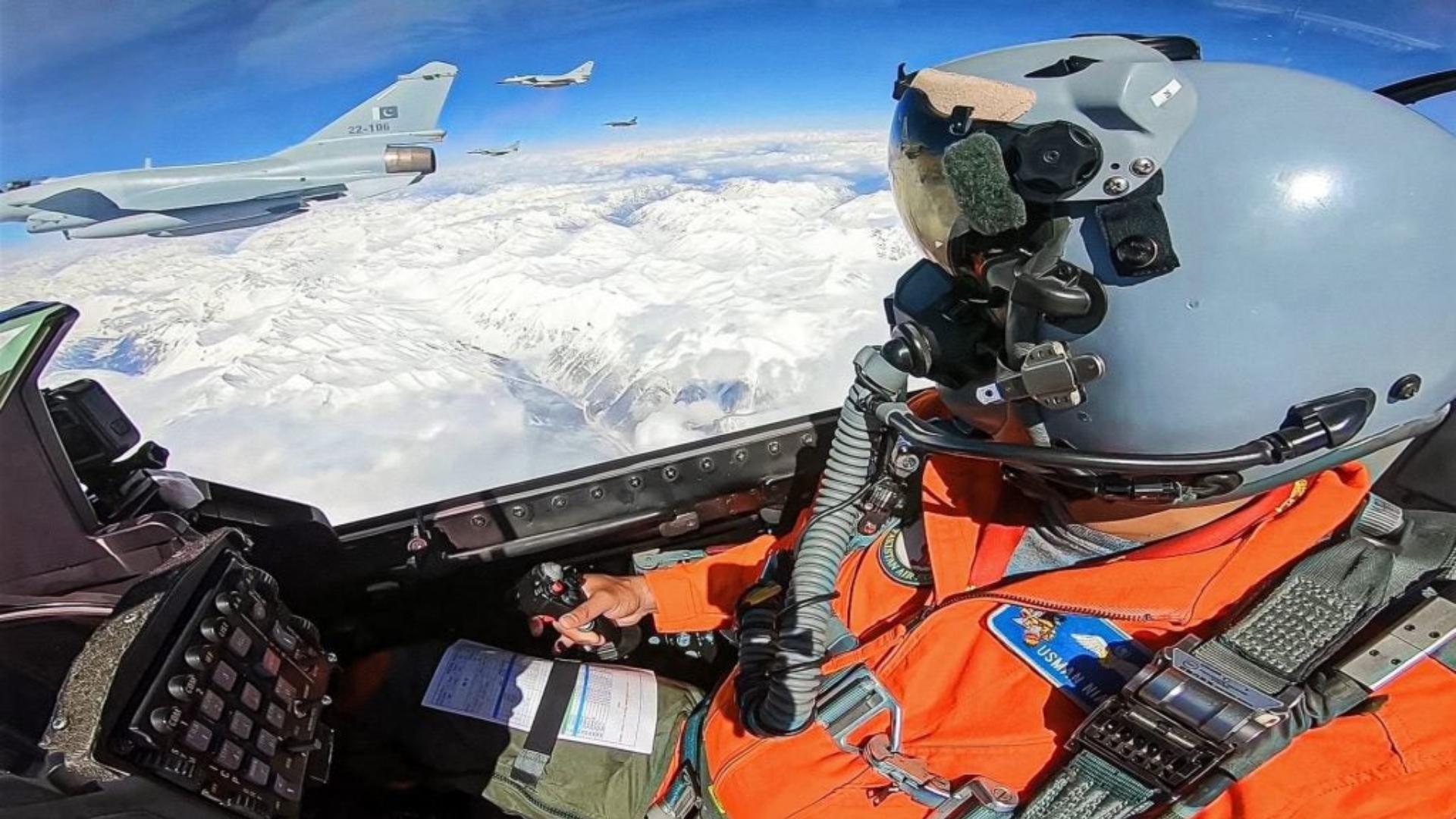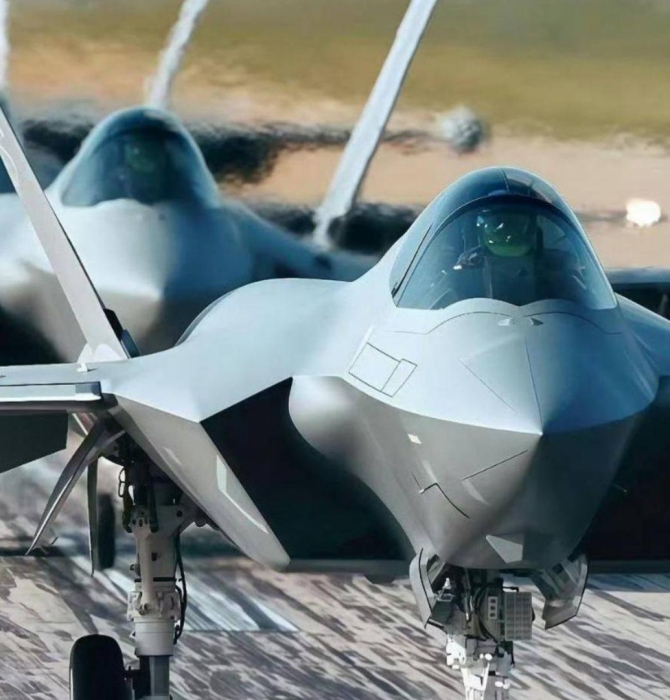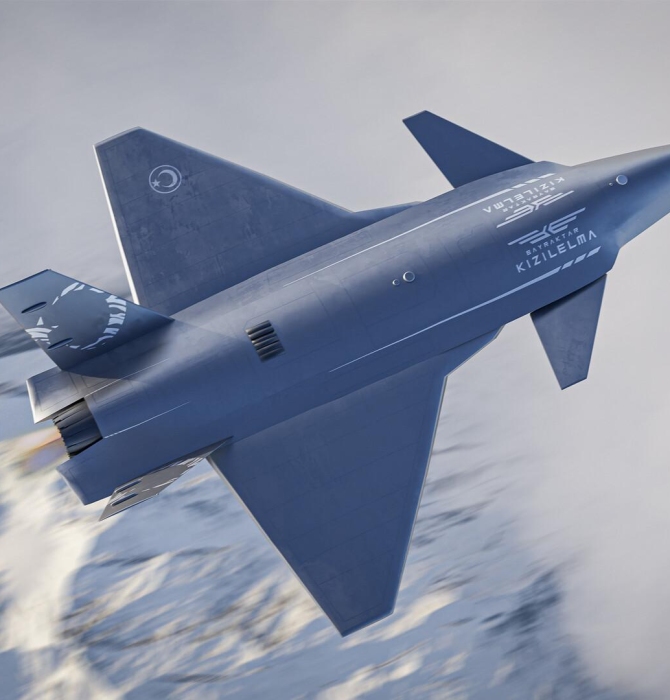5452Views

Pakistan’s Next Great Military Project Isn’t a Fighter Jet – It’s an Invisible Network Defence Uncut Podcast
The future of air power is no longer solely about the kinematic performance of an aircraft – its speed, altitude, or maneuverability. Instead, the decisive factor in 21st-century conflict is information: the ability to see first, understand first, and act first.
This new paradigm, however, presents a fundamental and deeply challenging contradiction for military planners. How does a force communicate and collaborate seamlessly in the heat of battle, while simultaneously hiding in the electromagnetic shadows to strike with surprise?
This is the central tension of modern air warfare.
On one hand, you need to be “loud” – broadcasting, sharing, and networking vast amounts of sensor data across dozens of assets to create a dominant, unified picture of the battlespace.
On the other hand, you must be “silent” – operating with such a low electromagnetic profile that you are functionally invisible to an enemy’s vigilant electronic support measures. An aircraft or system that is only a little loud or a little silent is a compromise that will fail at both missions.
In the latest episode of the Defence Uncut podcast, we dive deep into this defining challenge, unpacking the technical and strategic imperatives behind developing a next-generation tactical data-link (TDL).
This isn’t just an upgrade; it’s about architecting an entirely new language of war, one capable of speaking in both a shout and a whisper.
For the Pakistan Air Force (PAF) and the country’s defense industry, mastering this dual-mode capability is not an esoteric “nice-to-have”; it is the essential ticket to remaining a credible force in an increasingly contested environment.
Listen to the full episode on YouTube or your favorite podcast platform.
This Week’s Defence News Briefing: From RIAT Debuts to New Attack Helicopters
Before delving into the complexities of data-links, the Defence Uncut team covered the week’s most significant developments, providing context for the broader strategic shifts underway.
JF-17C at RIAT 2025
The JF-17C, also known as the Block 3, made its international debut at the 2025 Royal International Air Tattoo (RIAT), continuing the type’s tradition of appearing at the prestigious airshow. While its presence signals the platform’s maturity, we discussed how the JF-17’s true value lies not just in the airframe, but in its role as a scalable, cost-effective node in a wider system-of-systems.
The ability to field a significant number of fighters equipped with modern active electronically scanned array (AESA) radars, as was likely the case during the May 7th air clash with the Indian Air Force (IAF), is a testament to the JF-17’s enduring strategic importance. It is the key to achieving combat mass with advanced capabilities.
Pakistan Army’s Z-10ME Attack Helicopter
On the Pakistan Army front, reports have emerged confirming that the Pakistan Army has begun receiving the Chinese-made Z-10ME attack helicopter.
In the podcast, we analyze how this acquisition is not merely a replacement for the cancelled Turkish T129 ATAK deal.
The Z-10ME’s design features – such as its integrated electronic countermeasures (ECM), improved sand filters, and upward-facing exhausts – are specifically tailored for survivability in the contested, conventional battlefields of Pakistan’s eastern front, not for counter-insurgency.
This procurement fills a critical anti-armor and desert operations capability gap, aligning the Army’s aviation corps with other modern Chinese systems like the VT-4 tank and SH-15 howitzer, creating a powerful incentive to organize these assets into a networked, combined-arms force.
The Rise of Jet-Powered Loitering Munitions
Finally, we touched on a global trend that Pakistan’s industry is uniquely positioned to exploit: the rise of jet-powered loitering munitions.
With Western firms like MBDA and Anduril unveiling what are essentially small, low-cost cruise missiles, we argue that Pakistan should be repurposing existing designs – like the KaGeM V3 or even the Sarfarosh/Sarkash loitering munition – into scalable attack and decoy platforms.
The key, as discussed in the episode, is empowering the private sector to mass-produce the simple, sub-1-kilonewton turbojets required for these systems, a task for which the technological threshold is surprisingly low.
In fact, Pakistan has already developed such turbojets; the next step is to diffuse or distribute the know-how to the Pakistani private sector so that broader munition production is not bottlenecked.
The Data-Link Dilemma: Why Link-17 is Not Enough
The core of our discussion focused on the profound limitations of legacy data-links in the face of future operational needs.
Systems like Link-16 (and by extension, Pakistan’s indigenous Link-17) were and continue to be crucial for network-enabled operations. Based on a Time Division Multiple Access (TDMA) scheme and rapid frequency-hopping, they created a secure, jam-resistant network that allowed different platforms to share pre-formatted messages.
However, for a modern stealth aircraft or a UCAV, Link-17 is far from enough due to the following factors:
- Low Bandwidth: With data rates akin to 1990s dial-up internet (around 115 kbps theoretical max), it cannot handle the raw sensor data, high-resolution imagery, or video streams generated by modern systems.
- Inherent Latency: Its TDMA structure, which allocates time slots for users to “speak,” creates delays that are unacceptable for the time-critical targeting cycles of UCAV-led air combat.
- A Beacon for the Enemy: By design, Link-17 is an omnidirectional broadcast. It transmits with high power in all directions to ensure everyone on the network can hear. For an adversary’s listening systems, this is a massive electronic beacon that instantly reveals the presence and can be used to triangulate the position of the transmitting aircraft, completely negating the core advantage of stealth.
This is where the concept of a dual-mode data-link becomes essential. A future system must be capable of operating in two distinct modes:
The “Loud” Mode
Optimized for collaborative, networked air-to-air combat. This is a high-power, high-throughput, jam-resistant waveform operating as a Mobile Ad-hoc Network (MANET), where every aircraft acts as a router for every other aircraft.
It prioritizes connectivity and situational awareness above all else, enabling machine-to-machine sharing of targeting data in a chaotic environment.
The “Silent” Mode
Optimized for stealth. This mode is built on the principles of Low Probability of Intercept and Low Probability of Detection (LPI/LPD).
It achieves this by using the absolute minimum power required and, most importantly, extreme directionality.
Using phased-array antennas, it sends a tight, pencil-thin beam of energy directly at the intended receiver, preventing the signal from radiating where an enemy could detect it. The premier example of this is the F-35’s Multifunctional Advanced Data Link (MADL).
The problem is that these two modes are architecturally and philosophically opposed. MADL, for all its stealth, creates an isolated communication bubble, perfect for a small flight of F-35s but incapable of networking with the broader force.
Pakistan’s Path Forward: A Software-Defined Future
So, how can Pakistan solve this complex puzzle? The answer, as we explore in the podcast, lies not in a single, monolithic piece of hardware, but in software. The enabling technology is the software defined radio (SDR) stack.
An SDR is a revolutionary piece of technology that decouples a radio’s function from its physical hardware. By shifting functions to software running on powerful, reconfigurable chips, a single SDR platform can execute radically different waveforms. This means the same radio could, in one instant, run a loud, high-power MANET waveform for air combat, and in the next, switch to a silent, highly directional LPI waveform for a stealthy ingress.
This software-centric approach is the key to creating a truly adaptable, future-proof communications system. And critically, Pakistan already possesses many of the foundational ingredients to pursue this path:
- SDR Expertise: Organizations like the National Radio & Telecommunication Corporation (NRTC) have demonstrated experience in developing indigenous SDRs.
- Phased-Array Technology: The work done at institutions like NUST, NESCOM, and NASTP on Gallium Nitride (GaN)-based AESA radar technology provides the core competency for the advanced antennas required for directional data-links.
- Systems Integration: The development of the JF-17 Block 3’s integrated electronic warfare (EW) suite, which reportedly uses antennas embedded in the airframe, proves a growing capability in complex, on-board systems integration.
The ultimate challenge, we argue, is not the hardware but the immense complexity of the software and the overarching systems integration required to marry these disparate elements into a cohesive whole.
This is where organizations like the National Aerospace Science and Technology Park (NASTP) could, and should, play a pivotal role. By making a strategic pivot to become a powerhouse for defense software development, NASTP could harness the nation’s civilian talent to build the “brains” behind the future force.
This is a long and arduous road.
In the interim, Pakistan will likely induct next-generation capabilities in self-contained “bubbles,” for example, by potentially procuring a package of Chinese platforms like the J-35 fighter and KJ-500 airborne early warning and control (AEW&C) system that come with their own inherent, data-links. While effective, this approach also creates long-term dependencies.
The development of a sovereign, dual-mode data-link architecture is therefore more than a technical project; it is a strategic imperative. It is about building the connective tissue for the entire force, ensuring that Pakistan can not only field advanced platforms but can leverage them to their full, networked potential in the defining conflicts of the future.
Listen to the Full Discussion
To understand the full scope of this challenge – from the physics of LPI waveforms to the choices facing the PAF – tune in to the complete episode of Defence Uncut. We break one of the most complex and critical topics in modern defence with the depth and clarity you won’t find anywhere else.
Find the episode now on YouTube and all major podcast platforms. To get our analysis delivered directly to your inbox, subscribe to the Quwa newsletter.
For exclusive reports, including Arslan Khan’s detailed paper on this very topic, consider becoming a Quwa Premium subscriber.
If you would like to read more about what was discussed in this episode, check out the links below:
- Is a Loyal Wingman UCAV on Pakistan’s Procurement Roadmap?
- PAF’s NASTP Sets Upgrade Path for JF-17 (or ‘PFX Alpha’)
- Pakistan Reveals ‘JF-17 PFX’ Program
If you have any questions, comments, or news topic suggestions you would like to hear us discuss, then send us an email at podcast@quwa.org.


